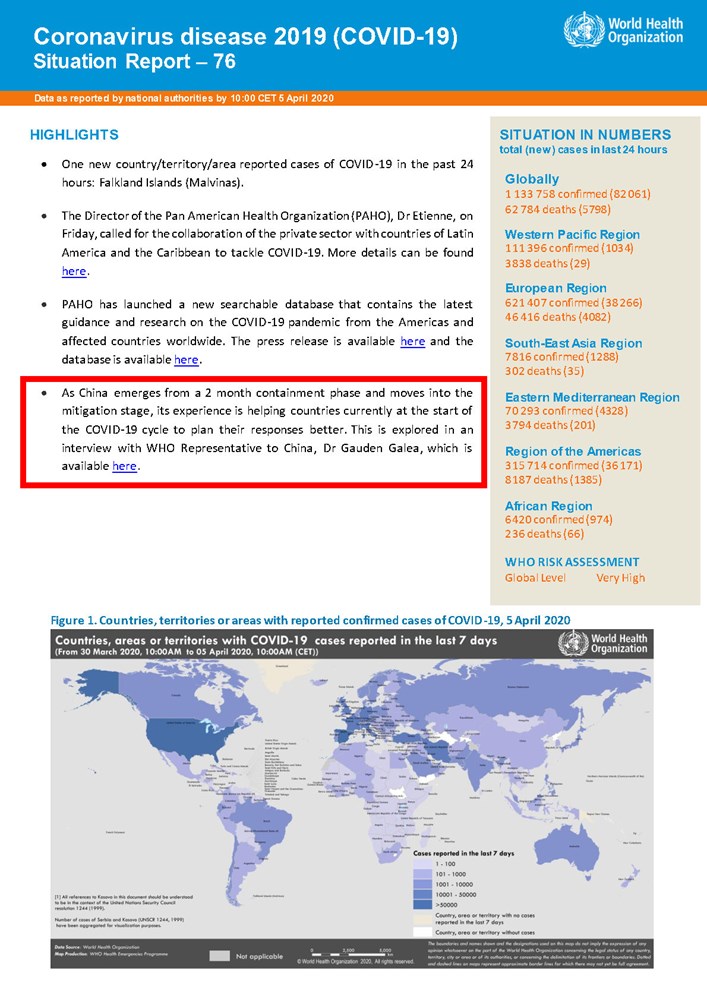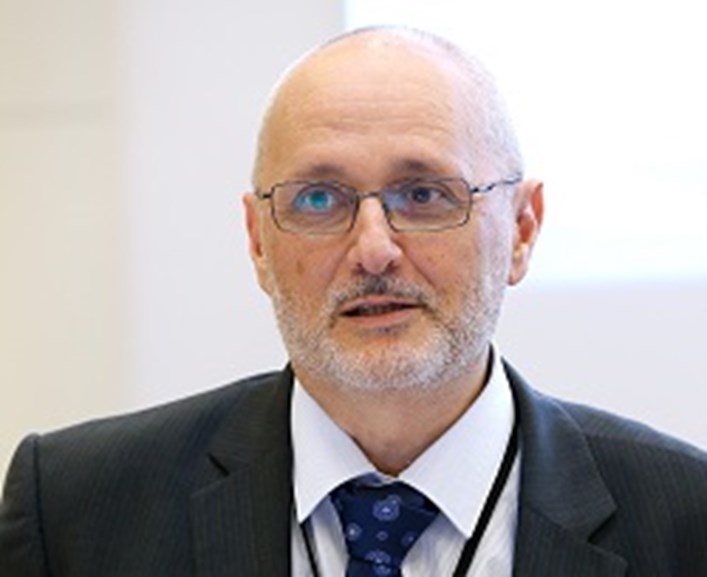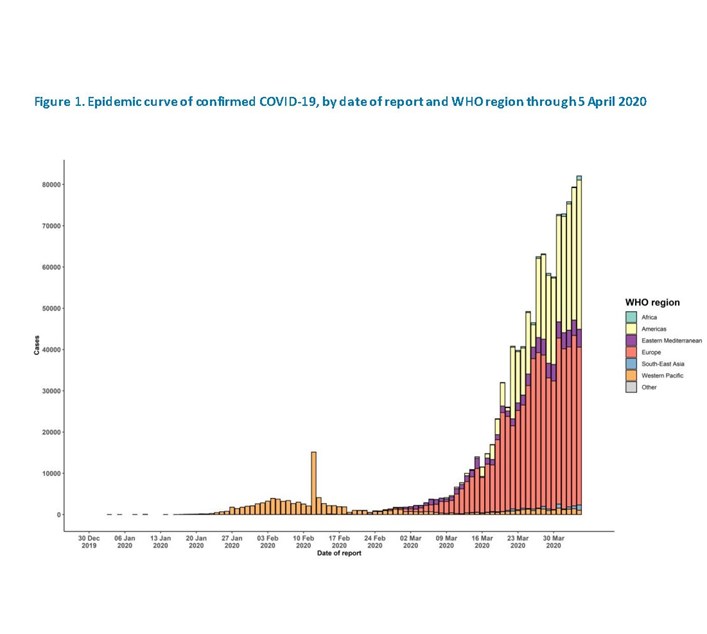WHO: “China shows COVID-19 responses must be tailored to the local context”
From the time when the first cases of COVID-19 were identified in Wuhan City, China, in December 2019, WHO has been at the forefront of the country’s containment efforts. The WHO Country Office in China, supported by the Regional Office for the Western Pacific and global headquarters, has provided the Government of China with technical advice on detection, testing, isolation and quarantine measures to support a rapid response to contain the outbreak.

As China emerges from the containment phase of the outbreak after 2 months and moves into the mitigation stage, its experience is helping countries currently at the start of the COVID-19 cycle to plan their responses better.
 Dr Gauden Galea, WHO Representative in ChinaIn an interview with WHO/Europe, the WHO Representative to China, Dr Gauden Galea, spoke about the next phase of China’s response to the pandemic and what lessons other countries should draw from its experience. These are excerpts from the interview.
Dr Gauden Galea, WHO Representative in ChinaIn an interview with WHO/Europe, the WHO Representative to China, Dr Gauden Galea, spoke about the next phase of China’s response to the pandemic and what lessons other countries should draw from its experience. These are excerpts from the interview.
Current situation in China
China has gone from being the epicentre of the COVID-19 pandemic to now representing less than a quarter of global cases, and we now have as much to learn from the rest of the global community as to offer from our experience in China.
At its peak in February, China was reporting 3800 new cases of COVID-19 in a single day. The fact that the number of new cases continues to decrease with every passing day shows that the extraordinary effort made by the Chinese population to limit transmission of COVID-19 – through social distancing, quarantine, and careful hand and respiratory hygiene – has made a difference.
Next phase of response for China
It is far too early to declare this outbreak under control. We cannot say that in China we have passed the peak, we say we have passed one of the peaks, and we are doing our best to help prevent a resurgence.
China’s first phase of public health response to COVID-19 focused on short-term measures to stop the virus spreading from Hubei to the rest of the country, and within the general population. School closures, transport bans and workplace shutdowns helped to limit transmission of COVID-19.
As these temporary containment measures are gradually lifted, the next phase of public health response is focused on mitigating the risk of COVID-19 across the general population over the long term. This means finding ways to integrate infection prevention and control as a routine part of daily life for everyone across all settings.
In China, as schools, workplaces, shopping centres and restaurants reopen their doors, we all – employers, staff, contractors, parents, children – have a key role to play in fighting COVID-19. Staying healthy over the next phase of COVID-19 is everybody’s business.

What can other countries learn from China's COVID-19 response?
China amassed significant experience in COVID-19. One area that China has been very effective in has been implementing a differentiated, location-specific response to limiting transmission, so that public health measures are tailored to the differing realities on the ground. Measures in Wuhan, for example, were very different than those implemented in other places such as Shanghai or Chengdu.
This is an important lesson for everyone – one size does not fit all. We know that with strong action, it is possible to push this virus back. But we also know that the situation in each country – sometimes even within countries – is different. Responses must be tailored carefully to the local context. What has worked in China, in Singapore, in Korea, may not be directly transferable to countries of the European Region. And, in turn, measures in the European Region may not necessarily be appropriate in other regions.
It is essential for countries to work together to share experiences and updates, to develop an agile and responsive approach, where each region and country’s guidance and advice can be quickly updated as understanding of the virus in the local context grows. Countries must learn from each other so that the world can develop the widest possible range of measures to fight this virus in different contexts.
How is WHO supporting the Government of China?
WHO has been working closely with the Government of China, providing technical advice to help the government plan and respond since the start of the year.WHO works closely with Chinese experts and other partners to better understand the virus and ensure all players work together in collaboration.
WHO also plays a critical role in providing advice to the public about how they can protect themselves and others – for example, explaining how hand and respiratory hygiene and social distancing limit transmission. WHO’s Chinese-language social media channels routinely reach tens of millions of people; our collective United Nations Country Team outreach during the outbreak has reached 1 billion people, and we’ve been able to document – through polling – that behaviours have changed, particularly with an increase in daily practices of handwashing, respiratory hygiene, social distancing and so on.
After the initial risk communications about the virus and personal protective measures, some of our more recent campaigns have been focused on preventing a resurgence, with topics like safely returning to work and school; encouraging people to pay attention to their mental health after 2 months of self-isolation; reminding people of the importance of healthy diets and habits, like not smoking; and so on.
What are some of the health challenges WHO anticipates longer term once China enters a recovery phase?
Health systems everywhere are struggling to cope with COVID-19 and China is no different. Hospital and health-care workers have been overwhelmed with testing and treatment. There has been an impact on routine services, such as childhood immunizations, chronic disease care, and the like.
Once China enters a recovery phase, there will be a range of longer term health priorities for China. We can expect mental health needs to be very significant as people start to rebuild lives and cope with the impact of the disease on their communities and livelihoods. It will be essential to resume reliable management of chronic diseases, such as tuberculosis, diabetes and cancer. Many people have struggled to access treatment and medicines over the last 2 months, and managing this will be a burning priority. In a recovery phase, it will also be important for the Chinese population to better understand some of the risk factors that seem to be linked to COVID-19 severity – such as tobacco use and hypertension. Promoting healthy behaviours and living should become a collective public health priority in China.